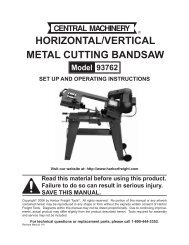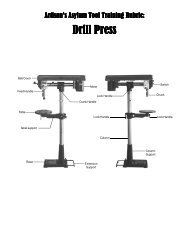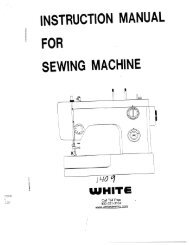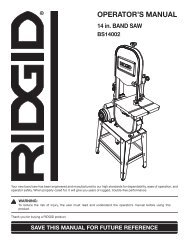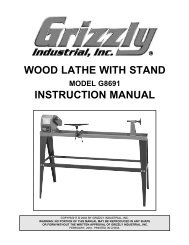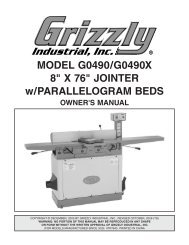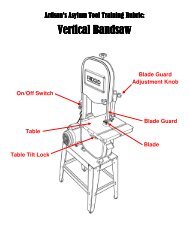Create successful ePaper yourself
Turn your PDF publications into a flip-book with our unique Google optimized e-Paper software.
4" <strong>Belt</strong> / 6" <strong>Disc</strong> <strong>Sander</strong>(Model SA446)INSTRUCTION MANUALPART NO. 905578 -05-03-02Copyright © 2002 Delta MachineryTo learn more about DELTA MACHINERYvisit our website at: www.deltamachinery.com.For Parts, Service, Warranty or other Assistance,please call 1-800-223-7278 (In Canada call 1-800-463-3582).ESPAÑOL: PÁGINA 21
GENERAL SAFETY RULESWoodworking can be dangerous if safe and proper operating procedures are not followed. As with all machinery, thereare certain hazards involved with the operation of the product. Using the machine with respect and caution willconsiderably lessen the possibility of personal injury. However, if normal safety precautions are overlooked or ignored,personal injury to the operator may result. Safety equipment such as guards, push sticks, hold-downs, featherboards,goggles, dust masks and hearing protection can reduce your potential for injury. But even the best guard won’t makeup for poor judgment, carelessness or inattention. Always use common sense and exercise caution in the workshop.If a procedure feels dangerous, don’t try it. Figure out an alternative procedure that feels safer. REMEMBER: Yourpersonal safety is your responsibility.<strong>This</strong> machine was designed for certain applications only. Delta Machinery strongly recommends that this machine notbe modified and/or used for any application other than that for which it was designed. If you have any questions relativeto a particular application, DO NOT use the machine until you have first contacted Delta to determine if it can or shouldbe performed on the product.Technical Service ManagerDelta Machinery4825 Highway 45 NorthJackson, TN 38305(IN CANADA: 505 SOUTHGATE DRIVE, GUELPH, ONTARIO N1H 6M7)WARNING: FAILURE TO FOLLOW THESE RULES MAY RESULT IN SERIOUS PERSONAL INJURY1. FOR YOUR OWN SAFETY, READ INSTRUCTIONMANUAL BEFORE OPERATING THE TOOL. Learn thetool’s application and limitations as well as the specifichazards peculiar to it.2. KEEP GUARDS IN PLACE and in working order.3. ALWAYS WEAR EYE PROTECTION. Wear safetyglasses. Everyday eyeglasses only have impact resistantlenses; they are not safety glasses. Also use face or dustmask if cutting operation is dusty. These safety glassesmust conform to ANSI Z87.1 requirements. NOTE:Approved glasses have Z87 printed or stamped on them.4. REMOVE ADJUSTING KEYS AND WRENCHES. Formhabit of checking to see that keys and adjusting wrenchesare removed from tool before turning it “on”.5. KEEP WORK AREA CLEAN. Cluttered areas andbenches invite accidents.6. DON’T USE IN DANGEROUS ENVIRONMENT. Don’tuse power tools in damp or wet locations, or expose themto rain. Keep work area well-lighted.7. KEEP CHILDREN AND VISITORS AWAY. All childrenand visitors should be kept a safe distance from work area.8. MAKE WORKSHOP CHILDPROOF – with padlocks,master switches, or by removing starter keys.9. DON’T FORCE TOOL. It will do the job better and besafer at the rate for which it was designed.10. USE RIGHT TOOL. Don’t force tool or attachment todo a job for which it was not designed.11. WEAR PROPER APPAREL. No loose clothing, gloves,neckties, rings, bracelets, or other jewelry to get caught inmoving parts. Nonslip footwear is recommended. Wearprotective hair covering to contain long hair.12. SECURE WORK. Use clamps or a vise to hold workwhen practical. It’s safer than using your hand and freesboth hands to operate tool.13. DON’T OVERREACH. Keep proper footing andbalance at all times.14. MAINTAIN TOOLS IN TOP CONDITION. Keep toolssharp and clean for best and safest performance. Followinstructions for lubricating and changing accessories.15. DISCONNECT TOOLS before servicing and whenchanging accessories such as blades, bits, cutters, etc.16. USE RECOMMENDED ACCESSORIES. The use ofaccessories and attachments not recommended by Deltamay cause hazards or risk of injury to persons.17. REDUCE THE RISK OF UNINTENTIONAL STARTING.Make sure switch is in “OFF” position before plugging inpower cord. In the event of a power failure, move switchto the “OFF” position.218. NEVER STAND ON TOOL. Serious injury could occur ifthe tool is tipped or if the cutting tool is accidentallycontacted.19. CHECK DAMAGED PARTS. Before further use of thetool, a guard or other part that is damaged should becarefully checked to ensure that it will operate properly andperform its intended function – check for alignment ofmoving parts, binding of moving parts, breakage of parts,mounting, and any other conditions that may affect itsoperation. A guard or other part that is damaged should beproperly repaired or replaced.20. DIRECTION OF FEED. Feed work into a blade orcutter against the direction of rotation of the blade or cutteronly.21. NEVER LEAVE TOOL RUNNING UNATTENDED.TURN POWER OFF. Don’t leave tool until it comes to acomplete stop.22. STAY ALERT, WATCH WHAT YOU ARE DOING, ANDUSE COMMON SENSE WHEN OPERATING A POWERTOOL. DO NOT USE TOOL WHILE TIRED OR UNDERTHE INFLUENCE OF DRUGS, ALCOHOL, ORMEDICATION. A moment of inattention while operatingpower tools may result in serious personal injury.23. MAKE SURE TOOL IS DISCONNECTED FROMPOWER SUPPLY while motor is being mounted,connected or reconnected.24. THE DUST GENERATED by certain woods and woodproducts can be injurious to your health. Always operatemachinery in well ventilated areas and provide for properdust removal. Use wood dust collection systems wheneverpossible.25. WARNING: SOME DUST CREATED BYPOWER SANDING, SAWING, GRINDING, DRILLING,AND OTHER CONSTRUCTION ACTIVITIES containschemicals known to cause cancer, birth defects or otherreproductive harm. Some examples of these chemicalsare:· lead from lead-based paints,· crystalline silica from bricks and cement and othermasonry products, and· arsenic and chromium from chemically-treated lumber.Your risk from these exposures varies, depending on howoften you do this type of work. To reduce your exposureto these chemicals: work in a well ventilated area, andwork with approved safety equipment, such as thosedust masks that are specially designed to filter outmicroscopic particles.SAVE THESE INSTRUCTIONS.Refer to them often and use them to instruct others.
ADDITIONAL SAFETY RULES FORBELT / DISC SANDERSWARNING: FAILURE TO FOLLOW THESE RULES MAY RESULT IN SERIOUS PERSONAL INJURY.1. DO NOT operate your machine until itis completely assembled and installed according to theinstructions.2. IF YOU ARE NOT thoroughly familiar with the operationof abrasive finishing machines, obtain advice fromyour supervisor, instructor or other qualified person.3. CAUTION: <strong>This</strong> machine is designed to sand woodor wood-like products only. Sanding or grinding othermaterials could result in fire, injury or damage to product.4. ALWAYS wear eye protection.5. THIS MACHINE is intended for indoor use only.6. IMPORTANT: Mount and use this machine on horizontalsurfaces only. Operating machine when mountedon non-horizontal surfaces might result in motordamage.7. IF THERE IS ANY TENDENCY for the machine totip over or move during certain operations such as whensanding long or heavy boards, the machine must besecurely fastened to a supporting surface.8. MAKE SURE the sanding belt is tracking correctlyin order that it does not run off the pulleys.9. MAKE SURE the sanding belt runs in the proper direction.See directional arrow on back side of belt.10. MAKE SURE the sanding belt or disc is not torn orloose.11. SUPPORT workpiece firmly with the miter gage,backstop or work table when sanding with the belt.NOTE: The only exception is curved work performed onthe top wheel of belt.12. ALWAYS hold the workpiece firmly on the tablewhen sanding on the disc.13. AVOID kickback by sanding in accordance withdirectional arrows. Sand on downward side of disc.Sanding on the upward side could cause the workpieceto fly up causing injury.14. ALWAYS maintain a maximum clearance of 1/16" orless between the table or backstop and the sanding beltor disc.15. NEVER wear gloves or hold the work with a ragwhen sanding.16. SAND with the grain of the wood.17. DO NOT sand pieces of material that are too smallto be safely supported.18. AVOID awkward hand positions where a suddenslip could cause a hand to move into the sanding belt ordisc.19. WHEN sanding a large workpiece, provideadditional support at table height.20. DO NOT sand with the workpiece unsupported.Support the workpiece with the backstop or table. Theonly exception is curved work performed on the outersanding drum.21. ALWAYS remove scrap pieces and other objectsfrom the table, backstop or belt before turning themachine “ON.”22. NEVER perform layout, assembly or set-up work onthe table while the sander is operating.23. ALWAYS turn the machine “OFF” and disconnectthe cord from the power source before installing orremoving accessories.24. NEVER leave the machine work area when thepower is “ON” or before the machine has come to acomplete stop.25. NEVER use solvents to clean plastic parts. Solventscould possibly dissolve or otherwise damage thematerial. Only a soft damp cloth should be used to cleanplastic parts.26. SHOULD any part of your sander be missing, damaged,or fail in any way, or any electrical components failto perform properly, shut off switch and remove plugfrom power supply outlet. Replace missing, damaged orfailed parts before resuming operation.27. THE USE of attachments and accessories notrecommended by Delta may result in the risk of injuries.28. ADDITIONAL INFORMATION regarding the safeand proper operation of this product is available from theNational Safety Council, 1121 Spring Lake Drive, Itasca,IL 60143-3201, in the Accident Prevention Manual for IndustrialOperations and also in the Safety Data Sheetsprovided by the NSC. Please also refer to the AmericanNational Standards Institute ANSI 01.1 Safety Requirementsfor Woodworking Machinery and the U.S. Departmentof Labor OSHA 1910.213 Regulations.SAVE THESE INSTRUCTIONS.Refer to them oftenand use them to instruct others.3
POWER CONNECTIONSA separate electrical circuit should be used for your machines. <strong>This</strong> circuit should not be less than #12 wire and shouldbe protected with a 20 Amp time lag fuse. If an extension cord is used, use only 3-wire extension cords which have 3-prong grounding type plugs and matching receptacle which will accept the machine’s plug. Before connecting themotor to the power line, make sure the switch is in the “OFF” position and be sure that the electric current is of thesame characteristics as indicated on the machine. All line connections should make good contact. Running on lowvoltage will damage the motor.WARNING: DO NOT EXPOSE THE MACHINE TO RAIN OR OPERATE THE MACHINE IN DAMP LOCATIONS.MOTOR SPECIFICATIONSYour machine is wired for 120 volt, 60 HZ alternating current. Before connecting the machine to the power source,make sure the switch is in the “OFF” position.GROUNDING INSTRUCTIONSWARNING: THIS MACHINE MUST BE GROUNDED WHILE IN USE TO PROTECT THE OPERATOR FROMELECTRIC SHOCK.1. All grounded, cord-connected machines:2. Grounded, cord-connected machines intended for useon a supply circuit having a nominal rating less than 150volts:In the event of a malfunction or breakdown, groundingprovides a path of least resistance for electric current toreduce the risk of electric shock. <strong>This</strong> machine isequipped with an electric cord having an equipmentgroundingconductor and a grounding plug. The plug mustbe plugged into a matching outlet that is properly installedand grounded in accordance with all local codes andordinances.Do not modify the plug provided - if it will not fit the outlet,have the proper outlet installed by a qualified electrician.Improper connection of the equipment-groundingconductor can result in risk of electric shock. Theconductor with insulation having an outer surface that isgreen with or without yellow stripes is the equipmentgroundingconductor. If repair or replacement of theelectric cord or plug is necessary, do not connect theequipment-grounding conductor to a live terminal.Check with a qualified electrician or service personnel if thegrounding instructions are not completely understood, or ifin doubt as to whether the machine is properly grounded.Use only 3-wire extension cords that have 3-pronggrounding type plugs and matching 3-conductorreceptacles that accept the machine’s plug, as shown inFig. A.Repair or replace damaged or worn cord immediately.If the machine is intended for use on a circuit that has anoutlet that looks like the one illustrated in Fig. A, themachine will have a grounding plug that looks like the plugillustrated in Fig. A. A temporary adapter, which looks likethe adapter illustrated in Fig. B, may be used to connectthis plug to a matching 2-conductor receptacle as shownin Fig. B if a properly grounded outlet is not available. Thetemporary adapter should be used only until a properlygrounded outlet can be installed by a qualified electrician.The green-colored rigid ear, lug, and the like, extendingfrom the adapter must be connected to a permanentground such as a properly grounded outlet box. Wheneverthe adapter is used, it must be held in place with a metalscrew.NOTE: In Canada, the use of a temporary adapter is notpermitted by the Canadian Electric Code.WARNING: IN ALL CASES, MAKE CERTAIN THERECEPTACLE IN QUESTION IS PROPERLYGROUNDED. IF YOU ARE NOT SURE HAVE AQUALIFIED ELECTRICIAN CHECK THE RECEPTACLE.GROUNDED OUTLET BOXCURRENTCARRYINGPRONGSGROUNDED OUTLET BOXGROUNDINGMEANSADAPTERGROUNDING BLADEIS LONGEST OF THE 3 BLADESFig. A4Fig. B
EXTENSION CORDSUse proper extension cords. Make sure your extension cord is in good condition and is a 3-wire extension cord whichhas a 3-prong grounding type plug and matching receptacle which will accept the machine’s plug. When using anextension cord, be sure to use one heavy enough to carry the current of the machine. An undersized cord will causea drop in line voltage, resulting in loss of power and overheating. Fig. D, shows the correct gauge to use dependingon the cord length. If in doubt, use the next heavier gauge. The smaller the gauge number, the heavier the cord.FOREWORDMINIMUM GAUGE EXTENSION CORDRECOMMENDED SIZES FOR USE WITH STATIONARY ELECTRIC MACHINESAmpere Total Length Gauge ofRating Volts of Cord in Feet Extension Cord0-6 120 up to 25 18 AWG0-6 120 25-50 16 AWG0-6 120 50-100 16 AWG0-6 120 100-150 14 AWG6-10 120 up to 25 18 AWG6-10 120 25-50 16 AWG6-10 120 50-100 14 AWG6-10 120 100-150 12 AWG10-12 120 up to 25 16 AWG10-12 120 25-50 16 AWG10-12 120 50-100 14 AWG10-12 120 100-150 12 AWG12-16 120 up to 25 14 AWG12-16 120 25-50 12 AWG12-16 120 GREATER THAN 50 FEET NOT RECOMMENDEDFig. DOPERATING INSTRUCTIONSThe Delta ShopMaster Model SA446 is a 4" <strong>Belt</strong>; 6" <strong>Disc</strong> <strong>Sander</strong> and comes equipped with; 1/3 hp 120 Volt SinglePhase Induction Motor, tilting table, miter gage, backstop, 4" x 36"- 60 grit sanding belt and 6"- 60 grit sanding disc.The tilting table can be mounted for use on either the belt or disc unit. The belt can be operated in the horizontalposition, the vertical position, and any position in between. The 3100 rpm disc and 2000 sfpm belt speed will handlemost sanding jobs in hard and soft wood.UNPACKING AND CLEANINGCarefully unpack the machine and all loose items from the shipping container(s). Remove the protective coating fromall unpainted surfaces. <strong>This</strong> coating may be removed with a soft cloth moistened with kerosene (do not use acetone,gasoline or lacquer thinner for this purpose). After cleaning, cover the unpainted surfaces with a good quality householdfloor paste wax.NOTICE: THE MANUAL COVER PHOTO ILLUSTRATES THE CURRENTPRODUCTION MODEL. ALL OTHER ILLUSTRATIONS ARE REPRESENTATIVEONLY AND MAY NOT DEPICT THE ACTUAL COLOR, LABELING ORACCESSORIES AND MAY BE INTENDED TO ILLUSTRATE TECHNIQUE ONLY.5
4" BELT / 6" DISC SANDER PARTS112342675678349 1011512Fig. 1AFig. 1BFig. 1A <strong>Sander</strong> PartsFig. 1B Hardware1. Motor and Base2. <strong>Disc</strong> Table3. <strong>Belt</strong> and Pulley Guard4. <strong>Disc</strong> Plate5. Dust Chute6. Support Rod7. Lower <strong>Disc</strong> Guard8. Sanding <strong>Disc</strong>9. Backstop10. Miter Gage11. 1/8" Hex Wrench12. 6mm Hex Wrench1. M8x1.25x20mm Hex Socket Head Screw (3)2. M6x1x30mm Cheese Head Screws (2)3. 1/4-20x1/2" Hex Head Screw (1)4. M5x.08x10mm Pan Head Screw (3)5. M4x.7x12mm Sheet Metal Screw (3)6. 5/16" Flat Washer (1)7. M5.3 Flat Washer (3)6
ASSEMBLY INSTRUCTIONSWARNING: FOR YOUR OWN SAFETY, DO NOT CONNECT THE SANDER TO THE POWER SOURCE UNTILTHE MACHINE IS COMPLETELY ASSEMBLED AND YOU READ AND UNDERSTAND THE ENTIRE OWNERSMANUAL.DEBADJUSTING BELT TENSIONYour sander was shipped from the factory with the drivebelt (A) Fig. 2, assembled to both pulleys (B) and (C).Before assembling the machine, check and adjust thebelt tension as follows:AFig. 2C1. Loosen screw (D) Fig. 2, with the 6mm hex wrench,and move sanding arm (E) to the vertical position toexpose belt tensioning screw (F) Fig. 3, and locknut (G).FG2. Check to see if the belt (A) Fig. 4, is tensionedproperly by applying light pressure to the belt at thecenter span of the pulleys as shown. NOTE: THERESHOULD BE APPROXIMATELY 1/4 INCH DEFLEC-TION IN THE BELT (A) AT THE CENTER SPAN OF THEPULLEYS USING LIGHT FINGER PRESSURE. THEBELT DOES NOT REQUIRE EXCESSIVE TENSION TOFUNCTION PROPERLY.3. If an adjustment is necessary, loosen locknut (G)Fig. 4, and tighten or loosen adjusting screw (F), with6mm hex wrench, until correct tension is obtained. Thentighten locknut (G).4. After belt tension is checked and adjusted if necessary,move the sanding arm to the horizontal position.Fig. 3AFig. 4FG7
ASSEMBLING BELTAND PULLEY GUARDAssemble the belt and pulley guard (A) Fig. 5, to themachine base using the two M6x1x30mm cheese headscrews (B), as shown.ABASSEMBLINGSANDING DISC PLATE1. Back the 1/4-20x1/4" hex socket set screw (A) Fig.6, out of the hole, just enough so that the set screw is notextending into hole (B) Fig. 6, in the sanding plate.AFig. 5B2. Slide sanding disc plate (B) Fig. 7, on drive shaft (C)making sure flat on drive shaft is aligned with set screw(A) in hub of plate (B). Slide plate (B) onto shaft (C) untilplate surface and shaft are nearly flush. Shaft must notextend out past surface of plate.BCFig. 6A3. Insert the 1/8" hex wrench (D) Fig. 8, down throughslot in the back of belt and pulley guard and tighten setscrew against flat on shaft.Fig. 7DFig. 88
ASSEMBLINGSANDING DISC1. Make sure sanding disc plate (A) Fig. 9, is clean.A2. Peel backing from sanding disc and press disc (B)firmly into position all the way around the sanding plate,as shown in Fig. 9.BASSEMBLING LOWERCOVER FOR SANDING DISCAssemble the lower cover (A) Fig. 10, to the belt andpulley guard, using the three M4x.7x12mm sheet metalscrews (B).Fig. 9ABASSEMBLINGDISC SANDER TABLE1. Thread a M8x1.25x20mm hex socket head screw(A) Fig. 11, part-way into threaded hole in base of sanderand insert rod (B) into hole as shown. Align flat on rod (B)with screw (A) and tighten screw (A).AFig. 10BFig. 112. Slide table assembly (C) Fig. 12, onto rod (B) asshown.3. Thread M8x1.25x20mm hex socket head screw (D)Fig. 12, into hole in table support bracket as shown.Align flat on rod (B) with screw (D) and tighten screw (D).FE4. WARNING: TO AVOID TRAPPING THE WORKOR FINGERS BETWEEN THE TABLE AND SANDINGDISC, THE TABLE EDGE (E) FIG. 12, SHOULD BE PO-SITIONED A MAXIMUM OF 1/16" AWAY FROMSANDING DISC (F). LOOSEN SCREW (D) ANDADJUST TABLE ACCORDINGLY.DBCFig. 129
ASSEMBLING DUST CHUTEAlign the three holes in the dust chute (A) Fig. 13 with thethree holes in the left side of the sanding base. Place aM5.3 flat washer onto a M5x.08x10mm pan head screw(B) Fig. 13, and insert screw through hole in dust spoutand thread into taped hole in sander base. Repeat thisprocess for the two remaining holes.BAASSEMBLING BACKSTOPTO SANDING ARMAssemble backstop (A) Fig. 14, to the sanding arm usingthe 1/4-20x1/2" hex head screw (B) and 5/16" flatwasher (C).WARNING: TO AVOID TRAPPING THE WORK ORFINGERS BETWEEN THE BACKSTOP AND SANDINGBELT, THE EDGE (D) OF THE BACKSTOP SHOULD BEPOSITIONED A MAXIMUM OF 1/16 INCH AWAYFROM SANDING BELT (E).AEDFig. 13CBFig. 14FASTENING SANDER TO SUPPORTING SURFACE1. If your sander is to be used in a permanent location,it should be fastened securely to a firm supportingsurface, such as a stand or workbench using the fourholes, three of which are shown at (A) Fig. 15.AA2. The diagram, shown in Fig. 16, illustrates the sizeand center to center distance of the holes to be drilled inthe stand or workbench.Fig. 1510Fig. 16
3. An alternate method of securing the sander to asupporting surface is to fasten the sander base to amounting board 18" x 24" minimum size. The diagram,shown in Fig. 17, illustrates the size and center to centerdistance of the holes to be drilled in the mounting board.NOTE: For proper stability, the holes in the mountingboard must be countersunk at the bottom so screwheads are flush with bottom surface of the mountingboard.Fig. 174. Securely clamp the mounting board to a stand orworkbench using 2 or more “‘C” clamps, as shown inFig. 18.IMPORTANT: If there is any tendency for the stand orworkbench to move during operation, the stand or workbenchmust be fastened to the floor.Fig. 18STARTING ANDSTOPPING SANDERThe switch (A) Fig. 22, is located on the sander base.To turn the sander “ON” move the switch up to the “ON”position. To turn the sander “OFF” move the switchdown to the “OFF” position.OPERATING CONTROLSAND ADJUSTMENTSAFig. 2211
LOCKING SWITCH INTHE “OFF” POSITIONIMPORTANT: When the machine is not in use, the switchshould be locked in the “OFF” position to preventunauthorized use. <strong>This</strong> can be done by grasping theswitch toggle (B) Fig. 23, and pulling it out of the switchas shown. With the switch toggle (B) removed, the switchwill not operate. However, should the switch toggle beremoved while the machine is running, it can be turned“OFF” once, but cannot be restarted without insertingthe switch toggle (B).TRACKING THESANDING BELT1. Turn the switch “ON” and “OFF” and check to seeif the sanding belt tends to move to one side or theother on the two sanding drums. If the belt does notmove to one side or the other and rides on the centerof the sanding drums the belt is tracking properly.2. If the sanding belt moves toward the disc, turn thetracking knob (A) Fig. 24, counterclockwise 1/4 turn.BFig. 23A3. If the sanding belt moves away from the disc, turnthe tracking knob (A) Fig. 24, clockwise 1/4 turn.4. Turn the switch “ON” and “OFF” again, and checkto see if the sanding belt moves to one side or the otherand readjust tracking knob if necessary.BFig. 24CHANGING POSITIONOF SANDING ARM1. DISCONNECT MACHINE FROM POWER SOURCE.2. The sanding arm (A) can be used in the horizontalposition, as shown in Fig. 25; vertical position, as shownin Fig. 26; or any angle in between by loosening screw(B), positioning the arm (A) to the desired angle andtightening screw (B).Fig. 25AABFig. 2612
ADJUSTINGBACKSTOP SQUAREWITH SANDING BELT1. DISCONNECT MACHINE FROM POWER SOURCE.A2. When making this adjustment make sure the belttension lever (A) Fig. 28, is all the way to the left in thetightened position, as shown.3. Place a square (B) Fig. 29, on the sanding belt withone end of the square against the backstop, and checkto see if the backstop is square with the sanding belt.Fig. 284. If an adjustment is necessary, loosen screw (C)Fig. 29, and adjust the backstop accordingly.BTILTING THE TABLE1. DISCONNECT MACHINE FROM POWER SOURCE.2. The table can be tilted up to 45 degrees to the rightby loosening the table lock knob (A) Fig. 30, tilting thetable to the desired angle, and tightening table lock knob(A).CFig. 293. WARNING: AFTER TILTING, THE TABLE AS-SEMBLY MUST BE REPOSITIONED ON THE SUP-PORT ROD (B) FIG. 30, TO PROVIDE A MAXIMUM OF1/16 INCH DISTANCE BETWEEN THE SANDING DISC(C), AND THE EDGE (D) OF THE TABLE, TO AVOIDTRAPPING THE WORK OR FINGERS BETWEEN THEDISC AND TABLE. TO REPOSITION THE TABLEASSEMBLY, LOOSEN SCREW (E), MOVE TABLEASSEMBLY ON ROD (B), AND TIGHTEN SCREW (E).CDABADJUSTING TABLE SQUAREWITH SANDING DISC1. DISCONNECT MACHINE FROM POWER SOURCE.2. Using a combination square, place one end of thesquare on the table with the other end against thesanding disc, as shown in Fig. 31, and check to see if thetable is 90 degrees to the disc.3. If the table surface is not 90 degrees to the disc,loosen table lock knob (A) Fig. 31, adjust table squarewith disc and tighten lock knob (A).4. Adjust pointer (B) Fig. 31, to the 0 degree mark onthe angle scale.EFig. 30BA13Fig. 31
AADJUSTING MITER GAGESLOT PARALLEL WITHSANDING DISC1. DISCONNECT MACHINE FROM POWER SOURCE.Fig. 322. Using a combination square (A) in the miter gageslot, check the distance from the slot to each end of thesanding disc, as shown in Figs. 32 and 33. <strong>This</strong> distanceshould be the same.A3. If an adjustment to the table is necessary, loosenthe three screws (B) Fig. 34, that fasten the table to thetable mounting bracket and trunnion and adjust the tableaccordingly - then tighten the three screws (B).BFig. 33MITER GAGEA miter gage (A) Fig. 35, is supplied with your machineand is used with the disc table. The miter gage body (A)can be rotated right or left for angle or miter sanding byloosening lock knob (B), rotate miter gage body andtighten lock knob (B).Fig. 34ABFig. 3514
USING TABLE ASSEMBLYWITH SANDING BELTWhen the sanding arm (A) Fig. 36, is used in the verticalposition, the complete table assembly (B) can be movedfrom the disc unit to the belt unit as follows:ACD1. DISCONNECT MACHINE FROM POWER SOURCE.2. Remove the backstop (C) Fig. 36.3. Thread the M8x1.25x20mm hex socket head screw(D) Fig. 36, into base casting as shown. NOTE: Onlythread screw (D) partway into base casting.4. Loosen screw (E) Fig. 36, and remove tableassembly (B) from disc unit. Insert bar (F) into hole (G) onbelt unit and tighten screw (D).GHFig. 36EFB5. Fig. 37, illustrates the table assembly (B) assembledto the belt unit.GWARNING: THE TABLE EDGE (G) MUST BEPOSITIONED A MAXIMUM OF 1/16 INCH AWAYFROM THE SANDING BELT (H) TO AVOID TRAPPINGTHE WORK OR FINGERS BETWEEN THE TABLE ANDSANDING BELT.BDUST CHUTEA dust chute (A) Fig. 38, is supplied with your sander andcan be connected to a standard shop vacuum hose. Theoutside diameter of the opening of the dust spout is 2-1/2 inches.Fig. 37AWRENCH STORAGETwo holes are provided in the base casting and are usedfor storing the two wrenches (A) Fig. 39, supplied withthe sander.Fig. 38AFig. 3915
REPLACINGSANDING BELT1. DISCONNECT MACHINE FROM POWER SOURCE.2. Loosen screw (A) Fig. 40, and remove backstop (B).3. Slide tension lever (C) Fig. 41, to the right to releasetension on sanding belt and remove sanding belt (D) fromboth sanding drums, as shown.4. Slide new sanding belt over both sanding drumsmaking sure the belt will run in the direction of the arrowlocated on the inside of the belt.5. Re-apply belt tension by sliding tension lever (C)Fig. 41, to the left.BAFig. 406. Replace backstop which was removed in STEP 2.D7. Connect electrical power to the sander and check tosee if the belt is tracking properly. If not, refer to thesection “TRACKING THE SANDING BELT”.CREPLACINGSANDING DISCWhen it becomes necessary to replace the sanding disc,proceed as follows:Fig. 411. DISCONNECT MACHINE FROM POWER SOURCE.2. Loosen screw (A) Fig. 42, and remove tableassembly (B).ABFig. 423. Remove three screws (C) Fig. 43, and lower cover(D).DC16Fig. 43
4. Peel off old disc (E) as shown in Fig. 44.5. Make sure the disc plate (F) Fig. 44, is clean andpeel backing from new sanding disc. Press the newsanding disc firmly into position on disc plate (F) andreplace lower cover and table assembly which wereremoved in STEPS 2 and 3.FEFig. 44OPERATIONAAFig. 45 Fig. 46SURFACING OR EDGE SANDINGWITH SANDING BELTWhen surfacing, Fig. 45, or edge sanding, Fig. 46, thesanding arm is in the horizontal position and thebackstop (A) Figs. 45 and 46, must always be used toprevent the workpiece from being carried along the belt.Always hold the workpiece firmly, keeping your fingersaway from the sanding belt. Always keep the end of theworkpiece against the backstop and move theworkpiece evenly across the sanding belt. Apply onlyenough pressure to allow the sanding belt to removematerial. Use extra caution when sanding very thinpieces.WARNING: THE EDGE OF THE BACKSTOP MUSTBE POSITIONED A MAXIMUM OF 1/16 INCH AWAYFROM THE SANDING BELT TO AVOID TRAPPINGTHE WORK OR FINGERS BETWEEN THE BACKSTOPAND SANDING BELT.17
SANDING INSIDE CURVESInside curves can be sanded on the top sanding drum,as shown in Fig. 47.SANDING OUTSIDE CURVESOutside curves should be sanded on the sanding discas shown in Fig. 48.WARNING: ALWAYS SAND ON THE LEFT(DOWNWARD) SIDE OF THE SANDING DISC, ASSHOWN. SANDING ON THE RIGHT (UPWARD) SIDEOF THE SANDING DISC COULD CAUSE THEWORKPIECE TO FLY UP WHICH COULD BEHAZARDOUS.WARNING: THE EDGE OF THE TABLE MUST BEPOSITIONED A MAXIMUM OF 1/16 INCH AWAYFROM THE SANDING DISC TO AVOID TRAPPINGTHE WORK OR FINGERS BETWEEN THE TABLE ANDSANDING DISC.END SANDINGWITH THE BELTWhen sanding the ends of wide workpieces it is moreconvenient to use the sanding belt with the sanding armin the vertical position and the table assembly moved tothe sanding belt, as shown in Fig. 49. See sections titled“CHANGING POSITION OF SANDING ARM” and“USING TABLE ASSEMBLY WITH SANDING BELT”.Fig. 47Fig. 48For more accurate work use the miter gage (supplied asstandard equipment) and move the work evenly acrossthe sanding belt, as shown in Fig. 49.WARNING: THE EDGE OF THE TABLE MUST BEPOSITIONED A MAXIMUM OF 1/16 INCH AWAYFROM THE SANDING BELT TO AVOID TRAPPINGTHE WORK OR FINGERS BETWEEN THE TABLE ANDSANDING BELT.END SANDINGWITH THE DISCWhen sanding the ends of narrow workpieces use thesanding disc and the miter gage, as shown in Fig. 50.Move the work from the center to the left side of thesanding disc.WARNING: ALWAYS SAND ON THE LEFT (DOWN-WARD) SIDE OF THE SANDING DISC, AS SHOWN.SANDING ON THE RIGHT (UPWARD) SIDE OF THESANDING DISC COULD CAUSE THE WORKPIECE TOFLY UP WHICH COULD BE HAZARDOUS.WARNING: THE EDGE OF THE TABLE MUST BEPOSITIONED A MAXIMUM OF 1/16 INCH AWAYFROM THE SANDING DISC TO AVOID TRAPPINGTHE WORK OR FINGERS BETWEEN THE TABLE ANDSANDING DISC.18Fig. 49Fig. 50
NOTES19
ACCESSORIESA complete line of accessories is available from your Delta Supplier, Porter-Cable • Delta Factory Service Centers,and Delta Authorized Service Stations. Please visit our Web Site www.deltamachinery.com for a catalog orfor the name of your nearest supplier.WARNING: Since accessories other than those offered by Delta have not been testedwith this product, use of such accessories could be hazardous. For safest operation, onlyDelta recommended accessories should be used with this product.PARTS, SERVICE OR WARRANTY ASSISTANCEAll Delta Machines and accessories are manufactured to high quality standards and are serviced by a networkof Porter-Cable • Delta Factory Service Centers and Delta Authorized Service Stations. To obtain additionalinformation regarding your Delta quality product or to obtain parts, service, warranty assistance, or the locationof the nearest service outlet, please call 1-800-223-7278 (In Canada call 1-800-463-3582).Two Year Limited WarrantyDelta will repair or replace, at its expense and at its option, any Delta machine, machine part, or machine accessory whichin normal use has proven to be defective in workmanship or material, provided that the customer returns the productprepaid to a Delta factory service center or authorized service station with proof of purchase of the product within twoyears and provides Delta with reasonable opportunity to verify the alleged defect by inspection. Delta may require thatelectric motors be returned prepaid to a motor manufacturer’s authorized station for inspection and repair or replacement.Delta will not be responsible for any asserted defect which has resulted from normal wear, misuse, abuse or repair oralteration made or specifically authorized by anyone other than an authorized Delta service facility or representative. Underno circumstances will Delta be liable for incidental or consequential damages resulting from defective products. <strong>This</strong>warranty is Delta’s sole warranty and sets forth the customer’s exclusive remedy, with respect to defective products; allother warranties, express or implied, whether of merchantability, fitness for purpose, or otherwise, are expresslydisclaimed by Delta.20Printed in U.S.A.



